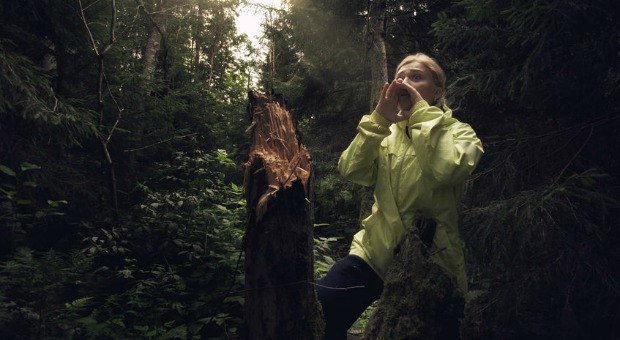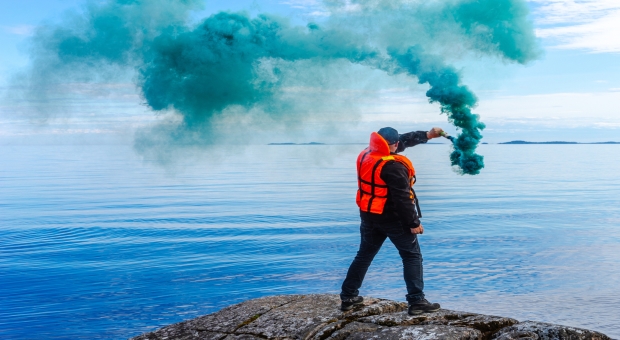If you get lost in the wild, you should be aware that search and rescue teams will probably use air resources as the primary means of determining your location. Okay, there may be also ground teams looking for “the lost sheep,” but in any situation, being capable of signaling for help in a survival scenario is of utmost importance.
When it comes to air search and rescue, agencies fly search patterns using small planes or helicopters in a grid pattern, mostly during the day. It’s worth mentioning that if we’re talking about extreme cases, they do perform search and rescue missions even at night, but you’ll have to consider yourself extra-lucky in such eventuality.
Ground search and rescue personnel may arrive at your location on horseback if the terrain is extra-difficult or by using 4×4 trucks, ATVs and sometimes even motorcycles. Tracking dogs are also commonly used in searches.
Now, try to consider getting lost, then being found from a logical standpoint, and from the eyes of the rescue team. Think about what would be the best way to find somebody if you were looking at the ground from a small fixed-wing aircraft, a helicopter, or a ground unit crisscrossing the land, looking along country routes and trying to see through trees. What about the folks walking area trails or driving pickup trucks on remote and sinister roadways? What would draw their attention?
Find a Good Spot
The first rule of escape survival is quite the opposite of the first rule of being lost. You need to know how to signaling for help: the former requires silence and invisibility, which includes avoiding clearings and roadways. The latter stipulates that you should find a large, open area then get out in the open and do everything you can to get noticed; that would be the first step to take in a SHTF, being lost scenario.
Hence, the first thing to do is to find a large open area that’s easy to reach from your shelter (if any). Speaking of large open areas, the spot must be wide enough to allow for a helicopter to land; it should be very large and flat, with no obstructing vegetation/trees/rocks on the ground. That would be the ideal setup. However, in a survival scenario, you’ll just have to settle for what you have close by, so just do the best you can.
Always avoid shaded/shadowed areas beneath/adjacent to rocks, big trees, and other obstacles that will obstruct somebody in the air’s view of you. Shady areas are excellent for hiding, but you’re looking for the opposite if you’re lost. You want to be easily seen from the ground or from the air.
Use Your Gear
The first thing you need to do after you find a good spot is take a look at your gear and at what’s readily available nearby. Check out and arrange/identify what can be used as a signaling tool. Evaluate each item and opportunity very carefully, as your life actually depends on it.
In our day and age, almost everybody carries a cell phone and/or a GPS gadget. However, high tech gear tends to die quickly and break easily. If you’re lucky enough to have a cell phone with a live battery and at least minimal network coverage, you can try to send an SMS message, even if you don’t have enough reception to initiate a phone call to 911 or a dear friend/ emergency contact. Try to send as much intel as possible in the simplest way, to the person you think most likely to see it immediately, or send the text to a group of people. Keep your text short, saying something like: “SOS 50deg48 min 51 sec N 122 deg 29 min 31 sec W fall w broken leg injured call 911” or something similar.
But that would be the best case scenario, isn’t it? Find an elevated position, snatch a little bit of signal, send a clever SMS and wait for the Air Cavalry to arrive. In reality, things are rarely that easy, so you may have to settle for the old way: signaling your location by using rocks, sticks, dirt, shadows, signal fires, and so on.
As the general rule of thumb, it’s very important to remember the CLASS acronym with regard to ground to air signaling.
C stands for Contrast. The best way to signal your presence is by using colors which are in contrast to the background. For example, dig a trench, thus creating a black shadow/writing against white snow. You could also use branches. Or, if the soil is covered in green vegetation, an orange tent would draw attention.
L stands for Location, and it refers to the open area (close to your shelter) I already told you about in the preamble.
A stands for Angularity, meaning that in order to catch your rescuer’s eyes, your signals must have as many straight lines and sharp corners as possible, because ninety degree corners in nature are a pretty rare occurrence.
S stands for Size. Size is everything, right? The bigger, the betterMake your letters and fires as big as possible, without burning the forest down.
Finally, the S stands for shape. A large V-shaped sign means that you’re looking for assistance/help, an X signifies that you’re injured, big arrows can be used for communicating the direction you’re traveling to, etc.
If you’re on the move, it’s very important to leave crystal-clear signals, like notes and arrows indicating your intentions, the direction you’re traveling to, or other details that will help your rescuers find you.
Use Signal Fires and Smoke
Now, getting back to business, the best (as in field-proven) method to make your presence noticed regardless of whether it’s day or night is by fire. Fire has been used for thousands of years for signaling for rescue, and it works beautifully. During the night, fire makes for the most effective visual means when it comes to signaling one’s presence.
The international distress signal follows the rule of three, i.e. you must build 3 fires in a straight line (25 meters between the fires) or in a triangle so that you’re not mistaken or a regular camper out having a good time. Always remember to build your fires somewhere visible from the air/distance, i.e. in a location where the foliage/natural obstacles will not hide it.
An excellent way to attract attention is to set a tree on fire by placing dry wood/combustible material in its lower branches and setting it ablaze. For producing smoke (during the day), add green leaves/small green trees to the fire. For best results, when signaling for help during the day, the color of the smoke should contrast with the background, i.e. white smoke against a dark background and vice versa.
A large fire smothered with moss or green leaves will produce white smoke. To get black smoke, you must add oil soaked rags or rubber to a fire. However, keep in mind that smoke signals are only effective on clear days, sans snow, rain or high winds.
If you want to get noticed by search and rescue teams in an effective manner, think along the lines of putting yourself at odds with your surroundings. That would require motion, contrast and sound.
By contrast, I am talking about displaying colors and shapes that are strikingly different from your natural surroundings. For example, you can use a space blanket, bright clothing, tarps, tents, ribbons or improvised flags. Searchers are constantly looking for camping equipment/manmade stuff, provided it’s obvious (as in visible) from both ground and air. Motion translates into creating movement that’s different (at odds) with a still landscape. Think along the lines of a flag pole.
In addition to signal pyres, you can also try to reveal your presence by building mounds, i.e. 3 large rock-made piles forming a triangle that can be easily noticed from the air (in an open area obviously). The taller the mounds, the better, as taller structures will cast larger shadows, thus making them more visible from distance.
Write a Message on the Ground
Depending on your location, you can also try to write a message/sign on the ground that can be noticed by search and rescue teams flying overhead. On sand, you can use a big branch to write an SOS/HELP ME message. On land, you may go for branches, rocks or anything else that can be gathered to create (as big as possible) letters.
Use a Mirror
Signal mirrors are used for both motion and contrast in sunlight, as they’re pretty good at providing directed flashes toward ground or air searchers. This type of signal goes a long way and it’s especially effective from an elevated position, such as a mountain or a tree-top.
If possible, try to get to the highest point available when signaling, thus maximizing your chances of getting rescued.
Video first seen on TJack Survival.
Use a Whistle
Audible signals are also worth considering, whether we’re talking about shooting your gun (3 shots spaced 5 seconds apart) or by using a whistle. Seriously speaking, there’s no excuse for not having a whistle in your EDC survival kit. Whistles require little effort (compared to yelling) and they never run out of ammo. Always remember the rule of threes when signaling, including when using a whistle.
Wave your Arms
If everything else fails or you don’t have anything else available, you can always try to attract attention via body signals by waving your arms to the side and down. But don’t hope for much when you’re using this method because you’re a tiny person in a world of waving trees, etc.
Finally, I’ve saved the best for last. Remember, we live in the 21th century and it’s the Year of the Lord 2017.
Use a Personal Locator Beacon (PLB)
What’s your excuse for not having one of these little bad boys with you every time you’re adventuring outdoors? Or even better, a PLB (personal locator beacon)? I know, they’re a bit expensive, but better safe than sorry, right?
Know that you know how to signal for help if lost in the wild, will you be able to protect your own in a life or death scenario?
Click the banner below and find out!
This article has been written by Chris Black for Survivopedia.






Pingback:How Not To Die If You're Lost In The Woods | Survivopedia | January 2, 2020
|